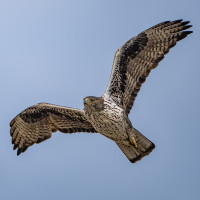Descrizione
A long cycle route starts here but of more interest to birdwatchers is the convenient c4-5 km circular walk through pine woods to a ridge and back down to the main track. The woodlands hold Luì bianco and Cincia dal ciuffo, open areas have Zigolo muciatto, Zigolo nero and Tottavilla and the low scrub a variety of ‘Sylvia’ warblers such as Sterpazzola, Occhiocotto and Magnanina comune. As with all footpaths beside the A 381 this is a good location to look for raptors particularly in spring and autumn when Aquila minore, Nibbio bruno, Falco pecchiaiolo and the odd Capovaccaio (plus Cicogna nera) pass through. Biancone (spring-autumn), Grifone , Sparviere and Poiana frequently appear but if you're lucky you may spot Aquila di Bonelli or Astore here. During passage periods expect Gruccione and pretty much any small passerine migrant.
Dettagli
Accesso
Take Exit 66 off the A 381 and then the service road south for just under 2km and pull over on to a dirt track on your left to explore the signposted Sendero La Teja Park and follow the paths.
Terreno e habitat
Foresta , Alberi e cespugli sparsi , MontagnaCaratteristiche dell’area
MontagnosoPercorso ad anello
SiÈ utile un cannocchiale?
NoBuona stagione per il BW
Primavera , AutunnoMiglior periodo per visitare
Migrazione primaverile , Primavera , Autunno , Migrazione autunnalePercorso
Strada sterrata , Sentiero strettoGrado di difficoltà del percorso a piedi
FaticosoModalità di accesso
A piedi , BiciclettaCapanno/torretta di osservazione
NoInformazioni aggiuntive
The tracks here provide a variety of 'pan handle' walks from 4 km upwards allowing you to tailor your walk to your individual requirements most of the walks are fairly easy but there are several steep sections. Look out for various orchid species and the local Portuguese Sundew (Drosophyllum lusitanicum) which, unlike sundews in northern Europe, has attractive pale yellow flower making it easy to locate.





